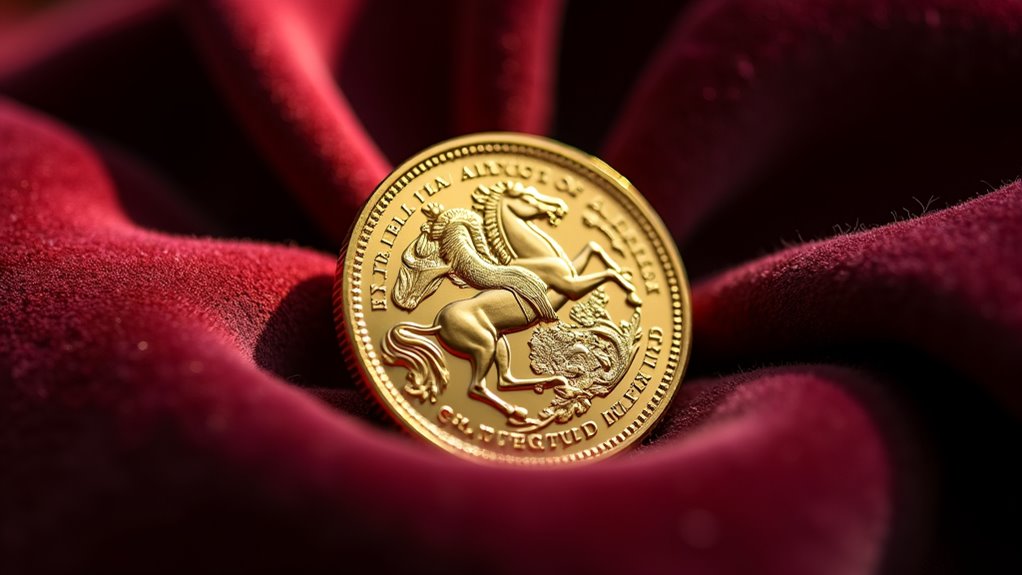Numismatic coin grading provides a standardised framework for evaluating collectible coins, using the Sheldon Scale from 1 to 70. Professional services like NGC and PCGS offer expert evaluation of factors including surface quality, strike sharpness, and lustre. Understanding the distinction between circulated (grades 1-59) and uncirculated (grades 60-70) coins is essential for market transactions. Proper handling and awareness of artificial alterations help preserve value, while mastering basic grading fundamentals opens doors to deeper market insights.

Numismatic Coin Grading
The intricate world of numismatic coin grading stands as a fundamental part of coin collecting and investment, providing collectors and dealers with a standardized system to evaluate a coin’s condition and worth. At the heart of this system lies the Sheldon Scale, which ranks coins from 1 to 70, with pristine specimens achieving the coveted grade of 70. This universal scale has revolutionized how the numismatic community assesses and values coins, creating a common language for buyers and sellers worldwide. Additionally, professional grading services ensure that each coin’s quality is assessed consistently across the market.
Professional grading services play an important role in maintaining market integrity through their rigorous evaluation processes. Organizations such as NGC, PCGS, and ANACS offer expert assessment and encapsulation services, protecting coins from environmental damage whilst guaranteeing their authenticity. These services scrutinize multiple factors, including surface quality, strike sharpness, lustre, and overall eye appeal to determine a coin’s grade. This process can be likened to gold hallmarking, where a standardized method ensures the purity and trustworthiness of precious metals. Furthermore, becoming a certified numismatist enhances one’s credibility in the field and can lead to better opportunities for collaboration and sales. The grading of semi numismatic coins also adds a layer of complexity, as they can possess both bullion and collector value that needs careful consideration.
Professional coin grading services ensure market confidence through expert evaluation, authentication, and protective encapsulation of numismatic specimens.
The distinction between circulated and uncirculated coins marks a significant threshold in the grading spectrum. Coins graded 1-59 show varying degrees of wear from circulation, while grades 60-70 represent mint state pieces that have never been used as currency. This delineation greatly impacts value, with uncirculated coins typically commanding premium prices in the marketplace.
Understanding the relationship between adjectival and numeric grading systems helps collectors navigate the market more effectively. While terms like “Poor” or “Mint State” provide general descriptions, the numeric system offers more precise evaluations. However, both systems serve important purposes, with adjectival grades commonly used for bulk submissions of common coins.
Buyers and sellers must remain vigilant about common pitfalls in the grading process. Artificial alterations, such as cleaning, can permanently diminish a coin’s grade and value. Similarly, improper handling during assessment or storage may result in surface damage that affects grading outcomes. It’s important to recognize that even slight variations in grade can lead to substantial differences in market value.
The financial implications of accurate grading cannot be overstated. Misgraded coins can result in considerable losses for both buyers and sellers, making it essential to rely on reputable grading services. Collectors should develop basic grading skills before submission and avoid unnecessary cleaning or handling that might compromise a coin’s condition.
Market awareness and understanding of grade rarity play crucial roles in successful numismatic transactions. Collectors should study price trends and recognize that demand often varies dramatically between different grade levels of the same coin. This knowledge, combined with proper grading practices, helps guarantee fair transactions and protects both buyers and sellers in the numismatic marketplace. Moreover, choosing the right numismatic grading service is vital to ensuring accurate evaluations and maintaining trust within the collecting community.
Frequently Asked Questions
How Much Does Professional Coin Grading Typically Cost?
Professional coin grading costs typically range from $85 to $150 per coin when accounting for all associated fees.
Basic grading services start at around $17-25 per coin, while premium services can exceed $350 plus additional charges for high-value pieces.
Economy options are available for coins valued under $300, though costs vary considerably based on the coin’s value, service level chosen, and whether expedited processing is required.
Can Damaged Coins Be Professionally Graded?
Yes, damaged coins can be professionally graded through a process called “details grading.”
Major grading services evaluate these coins based on their wear while noting specific impairments like cleaning, scratches, or corrosion.
While damaged coins typically receive lower grades than pristine specimens, professional grading still authenticates the piece and provides valuable documentation of its condition.
This can be particularly important for rare or historically significant coins, despite their imperfections.
How Long Does the Coin Grading Process Usually Take?
The coin grading timeframe varies considerably based on several factors.
Basic expert evaluations can take just 10-15 seconds, while complex specimens might require 1-2 minutes of careful assessment.
For professional grading services through companies like NGC or PCGS, the standard process typically takes 2-3 weeks.
Express options can reduce this to a few days, though additional shipping time of up to two weeks total should be factored into the timeline.
Should I Clean My Coins Before Submitting Them for Grading?
Professional numismatists strongly advise against cleaning coins before grading. Cleaning can greatly decrease a coin’s value and often results in a “details grade” rather than a numerical grade.
Even well-intentioned cleaning attempts frequently leave permanent damage like scratches or loss of original patina.
The only exception is when harmful contaminants like PVC are present – in these cases, professional conservation services should be consulted rather than attempting DIY cleaning.
Which Coin Grading Service Is Most Trusted by Collectors?
PCGS and NGC stand as the most trusted grading services in the numismatic community, with each having distinct strengths.
PCGS is particularly respected for U.S. coins, whilst NGC excels in world and ancient coin grading.
Both services maintain rigorous standards and are widely accepted in the marketplace.
CAC provides additional validation through its stickering process, creating an extra layer of confidence for high-end collectors seeking premium assurance.














